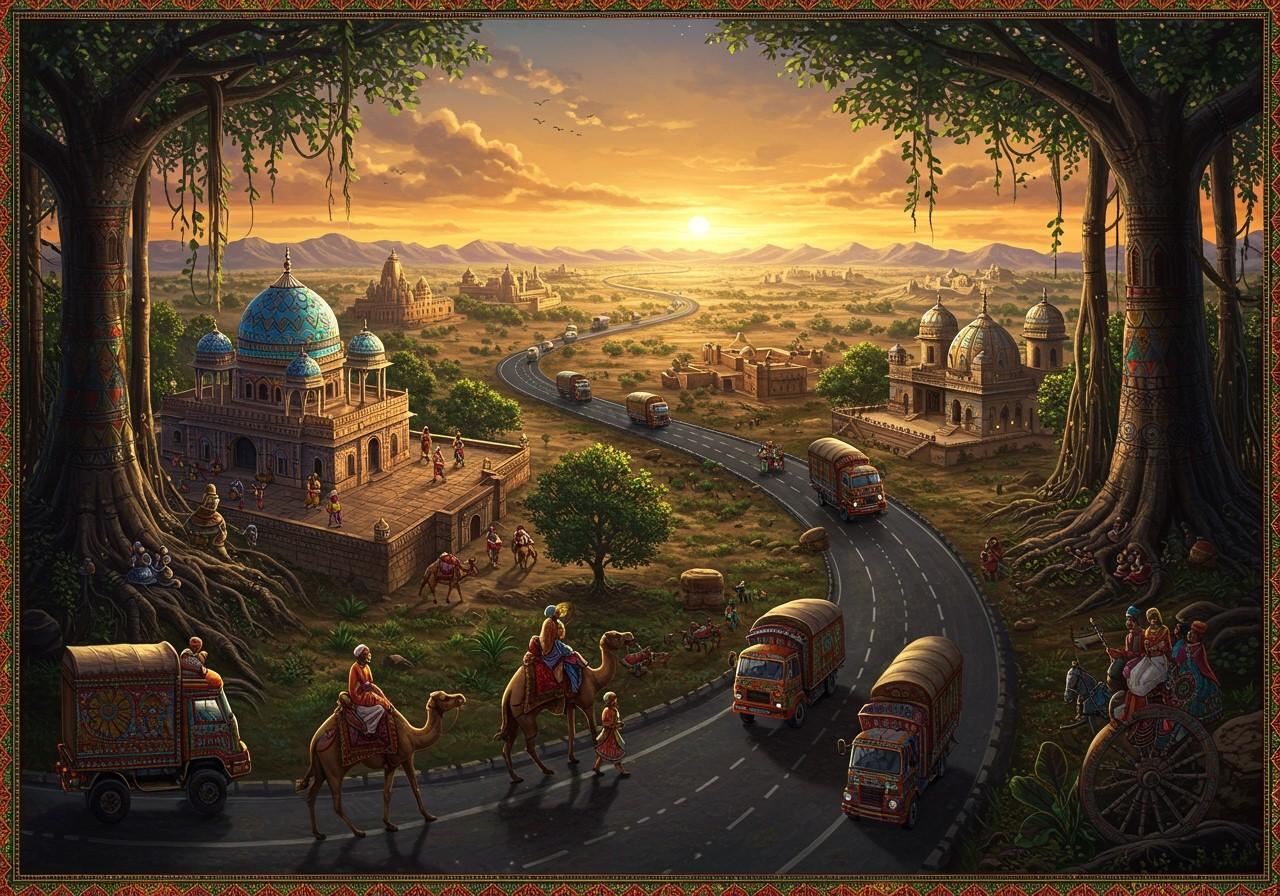
The Grand Trunk Road (GT Road), also known as Uttarapath, Sadak-e-Azam, or Badshahi Sadak, is one of South Asia’s oldest and longest major roads. Spanning at least 2,500 years, it connects Central Asia to the Indian subcontinent. The road runs approximately 3,655 km (2,271 mi) from Teknaf, Bangladesh, to Kabul, Afghanistan, passing through India and Pakistan. Historically known by various names, the GT Road has been crucial for fostering unity, prosperity, and cultural exchange. Despite the development of modern highways, it remains an essential and historically significant route in South Asia. In this article, we will explore the historical significance of the Grand Trunk Road and its journey through India’s past.
What is the Grand Trunk Road in India?
The Grand Trunk Road is an extensive and historic highway. A central artery for transportation and commerce, it connects major cities and rural areas alike. The GT Road is not just a road; it is a symbol of the subcontinent’s enduring legacy. Within India, the route traverses key states, including West Bengal, Bihar, Uttar Pradesh, Haryana, and Punjab. It connects prominent cities such as Kolkata, Delhi, Agra, Kanpur, and Amritsar, linking important cultural and historical sites along the way.
Who Built and When Was the Grand Trunk Road Constructed?
The origins of the Grand Trunk Road can be traced back to the Mauryan Empire, established by Chandragupta Maurya around 300 BCE. Sher Shah Suri, who ruled Northern India from 1540-1545, significantly modernized the road, establishing it as a major thoroughfare. He improved the infrastructure by building inns, wells, and planting trees along the route for travelers’ convenience. The road’s development continued under British rule from the mid-18th to mid-20th century, where it became a critical part of their infrastructure.
The Grand Trunk Road: A Timeless Journey Through India
History of the Grand Trunk Road
The Grand Trunk Road’s history reflects the evolution of the Indian subcontinent. It has witnessed major historical events, including army movements and population migrations. From empires rising and falling to revolutions unfolding and independence movements gaining momentum, the road’s legacy is deeply embedded in the region’s cultural and historical consciousness. Its importance grew during the British Raj, further enhancing its connectivity across the subcontinent.
Cultural and Historical Significance
The Grand Trunk Road is more than a physical path; it’s a cultural and historical lifeline. It facilitated the exchange of ideas, cultures, and traditions across the subcontinent, playing a key role in spreading Buddhism, Hinduism, and Islam. Immortalized in literature, folklore, and songs, it has captured generations’ imagination. The GT Road represents connectivity and unity amid diversity. Its historical milestones are celebrated through architecture and local festivals.
Modern Day Relevance
Today, the Grand Trunk Road remains a vital infrastructure for transportation and commerce in India. Despite modern advancements, it retains its historical charm and significance. The road serves as a reminder of India’s rich heritage and timeless journey of civilizations. It’s popular among travelers and history enthusiasts eager to explore its legacy. Its relevance extends beyond transportation, symbolizing the enduring connection between India’s past and present.
How Poojn.in Supports Your Journey Along the Grand Trunk Road
Poojn.in offers essential puja items and religious supplies for temples and sacred sites along the Grand Trunk Road. Our online platform makes it easy to access authentic ritual items needed for worship at important religious destinations, from Kolkata to Delhi. We provide:
- Temple offering items: Sourced from reliable suppliers, we offer a wide selection of incense, flowers, and coconuts perfect for traditional offerings. You can find everything you need for a reverent experience, whether you’re visiting a small shrine or a grand temple.
- Traditional brass and copper items for temple rituals: We offer a curated collection of handcrafted brass and copper items, including diyas, plates, and bells, essential for performing various temple rituals. These items are crafted with traditional techniques and add an element of authenticity to your worship.
- Pure cotton clothing suitable for temple visits: Dress respectfully for temple visits with our selection of pure cotton clothing. We offer comfortable and traditional attire for men, women, and children, ensuring you’re appropriately dressed for any religious occasion.
- Prayer beads and spiritual accessories: Enhance your spiritual practice with our range of prayer beads and accessories. These items are crafted from high-quality materials and are perfect for meditation, prayer, and personal reflection.
- Complete puja kits for various ceremonies: Simplify your puja preparations with our comprehensive puja kits. We offer kits for various ceremonies, containing all the necessary items, ensuring a smooth and convenient worship experience.
Order through our user-friendly website poojn.in or download our mobile app for delivery across India. We ensure all items meet traditional standards and are carefully packaged for safe delivery. Our customer service team can help you select the right items based on specific temple customs and regional practices. Note: For specific temple offerings, please check local customs and requirements before ordering.
Conclusion: The Enduring Legacy of the Grand Trunk Road
The Grand Trunk Road stands as a testament to India’s rich history and cultural diversity. From its origins in the Mauryan Empire to its modern-day relevance, this ancient highway has played a crucial role in shaping the subcontinent. The GT Road is not just a road; it is a journey through time, offering a glimpse into the soul of India.
Bhoganandishwara Temple: Weddings, Tradition, Serenity, and History
Bhutanatha Temples: Architecture, History, and Significance Explored
Mysuru Exploration: Chamundeshwari Temple and Culinary Delights
Pure Pik Whole Turmeric Sticks (Haldi, Gatiya, Gota Halud)
Aroma Aguru by Aroma Chemical


